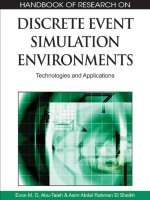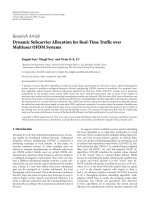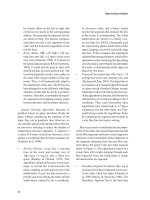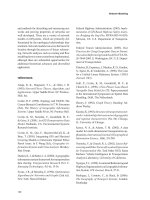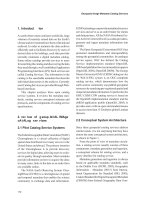Information science reference handbook of research on ubiquitous computing technology for real time enterprises jan 2008 ISBN 1599048329 pdf
Bạn đang xem bản rút gọn của tài liệu. Xem và tải ngay bản đầy đủ của tài liệu tại đây (14.34 MB, 640 trang )
Handbook of Research on
Ubiquitous Computing
Technology for Real Time
Enterprises
Max Mühlhäuser
Technische Universität Darmstadt, Germany
Iryna Gurevych
Technische Universität Darmstadt, Germany
InformatIon scIence reference
Hershey • New York
Acquisitions Editor:
Development Editor:
Editorial Assistants:
Senior Managing Editor:
Managing Editor:
Copy Editors:
Typesetter:
Cover Design:
Printed at:
Kristin Klinger
Kristin Roth
Ross Miller, Deborah Yahnke
Jennifer Neidig
Sara Reed
Alana Bubnis, Erin Meyer
Michael Brehm
Lisa Tosheff
Yurchak Printing Inc.
Published in the United States of America by
Information Science Reference (an imprint of IGI Global)
701 E. Chocolate Avenue, Suite 200
Hershey PA 17033
Tel: 717-533-8845
Fax: 717-533-8661
E-mail:
Web site:
and in the United Kingdom by
Information Science Reference (an imprint of IGI Global)
3 Henrietta Street
Covent Garden
London WC2E 8LU
Tel: 44 20 7240 0856
Fax: 44 20 7379 0609
Web site:
Copyright © 2008 by IGI Global. All rights reserved. No part of this publication may be reproduced, stored or distributed in any form or by
any means, electronic or mechanical, including photocopying, without written permission from the publisher.
Product or company names used in this set are for identification purposes only. Inclusion of the names of the products or companies does
not indicate a claim of ownership by IGI Global of the trademark or registered trademark.
Library of Congress Cataloging-in-Publication Data
Handbook of research on ubiquitous computing technology for real time enterprises / Max Muhlhauser and Iryna Gurevych, editors.
p. cm.
Summary: "This book combines the fundamental methods, algorithms, and concepts of pervasive computing with current innovations and
solutions to emerging challenges. It systemically covers such topics as network and application scalability, wireless network connectivity,
adaptability and "context-aware" computing, information technology security and liability, and human-computer interaction"--Provided by
publisher.
Includes bibliographical references and index.
ISBN-13: 978-1-59904-832-1 (hardcover)
ISBN-13: 978-1-59904-835-2 (ebook)
1. Ubiquitous computing--Handbooks, manuals, etc. 2. Real-time data processing--Handbooks, manuals, etc. I. Mühlhäuser, Max. II.
Gurevych, Iryna.
QA76.5915.H35 2007
004--dc22
2007032050
British Cataloguing in Publication Data
A Cataloguing in Publication record for this book is available from the British Library.
All work contributed to this book set is original material. The views expressed in this book are those of the authors, but not necessarily of
the publisher.
If a library purchased a print copy of this publication, please go to />for information on activating the library's complimentary electronic access to this publication.
Editorial Advisory Board
Erwin Aitenbichler
Technische Universität Darmstadt, Germany
Max Mühlhäuser
Technische Universität Darmstadt, Germany
Hidir Aras
University of Bremen, Germany
Christof Müller
Technische Universität Darmstadt, Germany
Gerhard Austaller
Technische Universität Darmstadt, Germany
Daniel Oberle
SAP Research, Germany
Alexander Behring
Technische Universität Darmstadt, Germany
Andreas Petter
Technische Universität Darmstadt, Germany
Dirk Bradler
Technische Universität Darmstadt, Germany
Robert Porzel
University of Bremen, Germany
Martin Faust
University of Bremen, Germany
Sebastian Ries
Technische Universität Darmstadt, Germany
Iryna Gurevych
Technische Universität Darmstadt, Germany
Dirk Schnelle
Technische Universität Darmstadt, Germany
Andreas Hartl
Technische Universität Darmstadt, Germany
Daniel Schreiber
Technische Universität Darmstadt, Germany
Melanie Hartmann
Technische Universität Darmstadt, Germany
Julian Schröder-Bernhardi
Technische Universität Darmstadt, Germany
Andreas Heinemann
Technische Universität Darmstadt, Germany
Jürgen Steimle
Technische Universität Darmstadt, Germany
Marc Herrlich
University of Bremen, Germany
Joachim Steinmetz
Technische Universität Darmstadt, Germany
Jussi Kangasharju
Technische Universität Darmstadt, Germany
Stefan-Georg Weber
Technische Universität Darmstadt, Germany
Tobias Klug
Technische Universität Darmstadt, Germany
Markus Weimar
Technische Universität Darmstadt, Germany
Tobias Limberger
Technische Universität Darmstadt, Germany
Torsten Zesch
Technische Universität Darmstadt, Germany
Fernando Lyardet
Technische Universität Darmstadt, Germany
Table of Contents
Detailed Table of Contents ................................................................................................................viii
Foreword ............................................................................................................................................ xvi
Preface ................................................................................................................................................ xix
Acknowledgment ................................................................................................................................ xli
Chapter I
Introduction to Ubiquitous Computing / Max Mühlhäuser and Iryna Gurevych ................................... 1
Section I
Scalability: Two Issues of Global Scale
Chapter II
Bionics: Learning from “The Born” / Tobias Limberger ...................................................................... 38
Chapter III
Ubiquitous Services and Business Processes / Alistair Barros............................................................. 57
Chapter IV
Ontologies for Scalable Services-Based Ubiquitous Computing / Daniel Oberle,
Christof Bornhövd, and Michael Altenhofen ........................................................................................ 88
Chapter V
Service Discovery / Gerhard Austaller ............................................................................................... 107
Section II
Connectivity: Tapping into Humans and Items
Chapter VI
Wireless and Mobile Communications / Jochen H. Schiller............................................................... 133
Chapter VII
Event-Based and Publish/Subscribe Communication / Erwin Aitenbichler........................................ 152
Chapter VIII
Peer-to-Peer Systems / Jussi Kangasharju.......................................................................................... 172
Chapter IX
Opportunistic Networks / Andreas Heinemann................................................................................... 190
Chapter X
Smart Items in Real Time Enterprises / Zoltán Nochta....................................................................... 211
Section III
Adaptability: What is (Not) Content?
Chapter XI
Context Models and Context Awareness / Melanie Hartmann and Gerhard Austaller....................... 235
Chapter XII
A Focus on Location Context / Erwin Aitenbichler............................................................................. 257
Chapter XIII
Adapting to the User / Matthias Jöst................................................................................................... 282
Section IV
Liability: From IT Security to Liability
Chapter XIV
Accounting and Charging: Guarantees and Contracts / Burkhard Stiller, David Hausheer,
Jan Gerke, Peter Racz, Cristian Morariu, and Martin Waldburger.................................................... 302
Chapter XV
Security for Ubiquitous Computing / Tobias Straub and Andreas Heinemann................................... 337
Chapter XVI
Trust and Accountability / Sebastian Ries........................................................................................... 363
Section V
Ease-of-Use: Natural and Multimodal Interaction
Chapter XVII
Mobile Speech Recognition / Dirk Schnelle........................................................................................ 397
Chapter XVIII
Mouth and Ear Interaction / Dirk Schnelle.......................................................................................... 421
Chapter XIX
Advanced Hands and Eyes Interaction / Michael Weber and Marc Hermann.................................... 445
Chapter XX
Intelligent User Interfaces for Ubiquitous Computing / Rainer Malaka............................................. 470
Chapter XXI
Multimodal and Federated Interaction / Frankie James and Rama Gurram....................................... 487
Chapter XXII
Multimodal Software Engineering / Andreas Hartl............................................................................. 508
Chapter XXIII
Ambient Learning / Fernando Lyardet................................................................................................ 530
Section VI
Pilots and Trends at SAP Research
Chapter XXIV
CoBIs: Collaborative Business Items / Patrik Spieß and Jens Müller................................................ 551
Chapter XXV
PROMISE: Product Lifecycle Management and Information Tracking
Using Smart Embedded Systems / Jürgen Anke, Bernhard Wolf, Gregor Hackenbroich,
Hong-Hai Do, Mario Neugebauer, and Anja Klein............................................................................. 559
Chapter XXVI
Real-Time Location Tracking Mashup for Enterprise / Louenas Hamdi, Rama Gurram, ,
and Samir Raiyani................................................................................................................................ 567
Chapter XXVII
Towards Adaptive Security for Ubiquitous Computing Systems: MOSQUITO and Serenity / Volkmar
Lotz,
Luca Compagna, and Konrad Wrona.................................................................................................. 574
Chapter XXVIII
Multimodal Warehouse Project / Samir Raiyani and Matthias Winkler ............................................585
Chapter XXIX
Business Grids: Grid Computing for Business Applications / Wolfgang Gerteis ............................... 591
About the Contributors ................................................................................................................... 601
Index ................................................................................................................................................... 611
Detailed Table of Contents
Foreword ............................................................................................................................................ xvi
Preface ................................................................................................................................................ xix
Acknowledgment ................................................................................................................................ xli
Chapter I
Introduction to Ubiquitous Computing / Max Mühlhäuser and Iryna Gurevych ................................... 1
The authors briefly describe the history of ubiquitous computing. Some terms and a few important
standards are subsequently introduced. In the last part, two kinds of reference architectures for ubiquitous
computing systems are discussed by way of example.
Section I
Scalability: Two Issues of Global Scale
Chapter II
Bionics: Learning from “The Born” / Tobias Limberger ...................................................................... 38
The chapter focuses on distributed approaches to address the scalability challenges in ubiquitous
computing by means of bio-analog algorithms, which draw upon the realm of biology. The author
describes the algorithms based on the phenomena found on the organism level of biological systems
and examines the algorithms imitating procedures both on the cell and the molecular levels. Bio-analog
approaches are finally extrapolated to data management as a novel field.
Chapter III
Ubiquitous Services and Business Processes / Alistair Barros............................................................. 57
The author describes service-oriented architecture (SOA) based on Web services interfaces and messaging,
and service composition through single-party process orchestration and multi-party choreography
languages. For the latter, concrete patterns are used to describe the capabilities of prospective standards.
Ways in which SOA needs to be extended to allow wider and more flexible service trading, typified in
current developments through service marketplaces, are then discussed. Such extensions converge
with directions in ubiquitous computing through so-called ubiquitous service networks and service
ecosystems.
Chapter IV
Ontologies for Scalable Services-Based Ubiquitous Computing / Daniel Oberle,
Christof Bornhövd, and Michael Altenhofen ........................................................................................ 88
Ontologies are proposed to address the scalability problems in ubiquitous computing, such as: (i)
identifying relevant services for deployment, (ii) verifying a composition by a logical rule framework,
and (iii) enabling the mapping of required services to the “best” available device. The authors focus
on the ontology languages emerging from the corresponding W3C Semantic Web Activity. The pros and
cons of ontologies are contrasted at a general level and the benefits and challenges in concrete smart
items middleware are demonstrated.
Chapter V
Service Discovery / Gerhard Austaller ............................................................................................... 107
The chapter briefly discusses the attributes that define SOA and the roles of the participants in a service
oriented environment. In essence, SOA permits clients in open systems to use services offered by a
service provider in the context of a workflow or complex task. Services are offered with a description at
well-known “places” (also called registries, repositories), where clients choose services according to
their needs. The chapter discusses several approaches to describing services and to searching for them.
Moreover, some well-known systems and current related research are discussed.
Section II
Connectivity: Tapping into Humans and items
Chapter VI
Wireless and Mobile Communications / Jochen H. Schiller .............................................................. 133
The chapter focuses on different wireless and mobile communication systems that form the technological
basis for ubiquitous computing applications. Depending on many parameters, such as transmission
range, desired data rates, cost, mobility, power consumption, scalability in the number of users, and
so forth, different communication systems have been developed. They are surveyed and compared and
future directions are highlighted.
Chapter VII
Event-Based and Publish/Subscribe Communication / Erwin Aitenbichler ....................................... 152
The chapter introduces a taxonomy of communication models and emphasizes the event-based model and
publish-subscribe paradigm that will supersede the client-server paradigm in the ubiquitous computing
era. The relevant aspects of the publish-subscribe paradigm are introduced along with known approaches.
The inner working of distributed event-based systems is thoroughly treated.
Chapter VIII
Peer-to-Peer Systems / Jussi Kangasharju ......................................................................................... 172
Wide-spread and novel application domains for peer-to-peer technology are described; challenges for
appropriate support of the latter are pointed out. Unstructured peer-to-peer networks and their variants
are contrasted with structured ones. The suitability and open issues in the context of ubiquitous computing
are highlighted.
Chapter IX
Opportunistic Networks / Andreas Heinemann .................................................................................. 190
Opportunistic networks support an increasingly interesting class of ubiquitous computing applications,
which deliberately limit connectivity to physical proximity of users. This application class and its variants
are described and contrasted with wireless ad hoc networks and mobile peer-to-peer systems. Important
human factors are treated, in particular privacy conservation and incentive schemes. Pertinent approaches
are introduced by way of examples.
Chapter X
Smart Items in Real Time Enterprises / Zoltán Nochta ...................................................................... 211
This chapter deals with the idea of how smart items, that is, electronically labeled and augmented physical
entities, can contribute to the overall vision of the real time enterprise by utilizing different ubiquitous
computing technologies. The main components of the smart items middleware are described.
Section III
Adaptability: What is (Not) Content?
Chapter XI
Context Models and Context Awareness / Melanie Hartmann and Gerhard Austaller...................... 235
This chapter gives an overview of how knowledge of the current context, that is, information characterizing
the situation, can be represented and how this knowledge can be used for enhancing applications. The
definitions of “context” and “context-aware applications” are given. The authors present guidelines
on how to build a context-aware application and some challenges in using context information are
discussed.
Chapter XII
A Focus on Location Context / Erwin Aitenbichler ............................................................................ 257
With respect to the important ubiquitous computing issue “context awareness,” location is presently
considered the most important and best supported context. Accordingly, the chapter starts with an overview
of relevant location determination technologies. A thorough treatment of the physical and mathematical
foundations of location determination follows. Both indoor and outdoor position are treated in detail.
The chapter also provides insight into a broad range of available positioning systems.
Chapter XIII
Adapting to the User / Matthias Jöst .................................................................................................. 282
Adaptation is needed to handle the increasing complexity in today’s computing environments. The chapter
focuses on the aspect of adaptation that puts the user into focus. It thus provides an important complement
to the adaptation via context-awareness that is emphasized in the ubiquitous computing community and
in the two preceding chapters. It introduces different adaptation types possible in ubiquitous computing,
like interaction, content, and presentation. Basic requirements for appropriately modelling the users
and approaches to personalize applications are presented.
Section IV
Liability: From IT Security to Liability
Chapter XIV
Accounting and Charging: Guarantees and Contracts / Burkhard Stiller, David Hausheer,
Jan Gerke, Peter Racz, Cristian Morariu, and Martin Waldburger ................................................... 302
For IP-based communications, charging is used as a comprehensive term for metering or monitoring,
accounting, pricing, charge calculation, and billing. These five actions are detailed in the chapter to
provide a clear view on their interdependencies as well as their relations to distributed computing. The
legal and contractual relationships between customers and providers as well as technological choices of
protocols, mechanisms, and parameters define the area of interest here. With their background purpose
of assuring and verifying exactly the flow of service provision and service remuneration intended,
the concepts described represent an important ingredient of future liability concepts for ubiquitous
computing
Chapter XV
Security for Ubiquitous Computing / Tobias Straub and Andreas Heinemann .................................. 337
The chapter motivates the need for a dedicated treatment of security in the context of ubiquitous
computing. It systematically discusses the particular security challenges and predominant security risks
in the ubiquitous computing context. The major part of the chapter is dedicated to the description of
sample solutions in order to illustrate the wealth of protection mechanisms required – and increasingly
available. An overview of cryptographic tools is given.
Chapter XVI
Trust and Accountability / Sebastian Ries .......................................................................................... 363
The chapter focuses on the concepts of trust and accountability. The author first introduces the semantics
of both concepts and then explains why trust is relevant for ubiquitous computing and what the main
issues for dealing with trust in computer science are. Then, the chapter discusses how accountability
can be achieved in distributed systems using reputation and micropayment mechanisms.
Section V
Ease-of-Use: Natural and Multimodal Interaction
Chapter XVII
Mobile Speech Recognition / Dirk Schnelle ....................................................................................... 397
This chapter is considered as a prerequisite for deeper understanding of the subsequent chapter. It gives
an overview of the main architectures to enable speech recognition on embedded devices, including
their characteristic features and properties. A description of the main challenges for the use of speech
recognition on embedded devices—and thus, in the ubiquitous computing context—is given. The author
provides a solid base for the selection of the most appropriate architecture for the business case of real
time enterprises.
Chapter XVIII
Mouth and Ear Interaction / Dirk Schnelle ......................................................................................... 421
Ubiquitous computing involves users on the move, suggesting hands-and-eyes-free operation, for which
speech is an obvious choice. The chapter gives an overview of the challenges that have to be mastered
in ubiquitous computing while working with audio, which is not easy to handle as a medium. To make
things worse, mouth and ear interaction is often performed without focusing attention on the device.
The author explains why audio-based interfaces are challenging to handle and shows how to master the
challenges and to improve the quality of applications involving mouth and ear interaction.
Chapter XIX
Advanced Hands and Eyes Interaction / Michael Weber and Marc Hermann ................................... 445
While mouth-and-ears interaction is becoming more important for ubiquitous computing, hands-and-eyes
interaction, especially in novel forms, remains essential. The chapter gives an overview of the broad
range of pertinent interaction techniques. The chapter gives a short introduction to the fundamentals
of human-computer interaction and the traditional user interfaces. It then surveys multi-scale output
devices, gives a general idea of hands and eyes input, specializes them by merging the virtual and real
world, and introduces attention and affection for enhancing the interaction with computers and especially
with disappearing computers.
Chapter XX
Intelligent User Interfaces for Ubiquitous Computing/ Rainer Malaka ............................................. 470
The chapter introduces a set of general approaches for designing user interfaces with a special focus
on the specific needs for ubiquitous computing scenarios. The author learns from good interface design
for other—classical—devices and applies many of those user interface design principles to ubiquitous
computing as well. A central aspect is the design process that helps to find the right sequence of steps
in building a good user interface.
Chapter XXI
Multimodal and Federated Interaction / Frankie James and Rama Gurram ...................................... 487
The authors first introduce some of the various modalities available for human-computer interaction.
Then, they discuss how multimodality can be used both in desktop and mobile computing environments.
The goal of the chapter is to familiarize scholars and researchers with the range of topics covered under
the heading “multimodality” and suggest new areas of research around the combination of modalities,
as well as the combination of mobile and stationary computing devices to improve usability.
Chapter XXII
Multimodal Software Engineering / Andreas Hartl ............................................................................ 508
Ubiquitous computing makes it necessary to supplant the desktop metaphor of graphical user interfaces
by other kinds of user interfaces for a multitude of devices and interaction modalities. The chapter
presents three different software engineering approaches that address this challenge: extensions to
Web-based approaches, abstract user interface definitions that add a level of abstraction to the user
interface definition, and model-based approaches that extend model-based application development to
integrate user interface issues as well.
Chapter XXIII
Ambient Learning / Fernando Lyardet ............................................................................................... 530
Ambient learning is a new area in ubiquitous computing, dealing with the different learning processes
that occur between people and smart technology environments. The chapter provides a definition of what
ambient learning is and discusses its relevance to ubiquitous computing. It presents the learning concepts
behind ambient learning and a detailed example of training a user. The technological building blocks
behind the smart products supporting their ability to learn from each other and assemble or “compose”
their functionality are examined in detail.
Section V
Pilots and Trends at SAP Research
Chapter XXIV
CoBIs: Collaborative Business Items / Patrik Spieß and Jens Müller ............................................... 551
The chapter describes an example of ubiquitous computing technology in a corporate environment. The
goal of the pilot was reduction of the risk in handling hazardous substances by detecting potentially
dangerous storage situations and raising alarms if certain rules are violated. The lesson learnt: if
employed in a shop floor, warehouse, or retail environment, UC technology can improve real-world
business processes, making them safer and more efficient.
Chapter XXV
PROMISE: Product Lifecycle Management and Information Tracking
Using Smart Embedded Systems / Jürgen Anke, Bernhard Wolf, Gregor Hackenbroich,
Hong-Hai Do, Mario Neugebauer, and Anja Klein ............................................................................ 559
The goals and application scenarios of the PROMISE project are presented. The PROMISE project aims to
close the information loop in product lifecycle management by employing product embedded information
devices (PEIDs) in products. Special attention is given to the middleware design and implementation
well as the role of universal plug and play (UPnP) as device-level protocol.
Chapter XXVI
Real-Time Location Tracking Mashup for Enterprise / Louenas Hamdi, Rama Gurram,
and Samir Raiyani............................................................................................................................... 567
The chapter describes a new automatic vehicle location (AVL) system designed to take advantage of
technologies that are currently gaining popularity in the enterprise, namely, online maps, real time GPS
location tracking, and service-oriented architectures. The system uses a service-oriented architecture and
Ajax-style user interface technology. The authors show that for Ajax technology to be widely adopted in
the applications involving real time data updates, a server-side push mechanism is needed.
Chapter XXVII
Towards Adaptive Security for Ubiquitous Computing Systems: MOSQUITO and Serenity / Volkmar
Lotz, Luca Compagna, and Konrad Wrona ........................................................................................ 574
The authors introduce two example projects that contribute to meeting the challenges in adaptive security.
The first project focuses on an architecture that allows for adaptive security in mobile environments based
on security services whose adaptation is guided by context information derived from sensor networks.
The second project addresses engineering aspects of secure ubiquitous computing systems through
making security solutions accessible and deployable on demand and following emerging applicationlevel requirements.
Chapter XXVIII
Multimodal Warehouse Project / Samir Raiyani and Matthias Winkler...............................................585
The Multimodal Warehouse Project is presented, which aims at applying multimodal interaction to a
warehouse picking process. The authors provide an overview of the warehouse picking procedure as well
as the overall architecture of the multimodal picking application and technologies applied to design the
application. Then, they describe the execution of user tests of the picking application at a warehouse
and present the results of these tests.
Chapter XXIX
Business Grids: Grid Computing for Business Applications / Wolfgang Gerteis ............................... 591
The second short contribution about emerging trends proposes business grids as a means to provide
enterprise computing infrastructures “as a utility” so that software and hardware resources (such as
applications, components, systems, and servers) can be easily operated under frequently changing
business conditions (such as changing strategies, models, processes, workload, etc.). The chapter details
the vision of business grids from various solution perspectives, describes the state-of-the-art in grid
computing and compares business grids and e-science grids.
About the Contributors ................................................................................................................... 601
Index ................................................................................................................................................... 611
xvi
Foreword
What’s In a name If It Is all In the Game?
When reading through the manuscript of this novel volume I was struck by the heroic attempt of the
editors to position their book as a holistic approach to the subject of ubiquitous computing. I found their
strong stand especially striking in this respect with respect to the use of nomenclature in the domain
of ubiquitous computing. The editors acknowledge that there are many different notions presented in
the literature addressing similar concepts as that of ubiquitous computing, but they argue that all these
notions should be considered as a single approach to the topic of the disappearing computer. More
specifically, the editors refuse to identify and describe the borderlines between different notions such as
ubiquitous computing, pervasive computing, and ambient intelligence, following their strong conviction
that it makes not much sense to quarrel about thin borderlines between major overlapping fields as their
exploration is still open to a large extent.
As a convert to the concept of ambient intelligence for almost ten years now I must admit that I continuously have felt the need in the past to explain these differences in an attempt to mark the borderlines.
Evidently, most of these notions, which were developed during the late nineties of the past century, are
rooted in the early ideas expressed by the late Mark Weiser, who was dreaming of a world that would be
flooded with embedded devices, note pads, and electronic dust, which would soon become feasible as
a result of the remarkable advances in the manufacturing of semiconductor devices and micro-systems.
However, the developments that have been achieved over the past ten years have shown that there can
be no doubt about the question whether or not Mark’s dream will come true; it surely will. The remaining question however is related to the issue of which form it will take and how it can be configured in
such a way that society and its participants maximally benefit from it. On the other hand, some of the
innovation directions have changed in the meantime, which has opened new venues for research. Great
inventions, such as ambient atmospheres through distributed solid-state lighting devices, virtual environments applying 3D interactive words such as Second Life, and ultimately “The Internet of Things”
have made the discussion about the differences between the various notions artificial and esoteric. More
interesting therefore is the question how far the advances in this domain have stretched the boundaries
of what is currently feasible. And again the editors deserve a compliment as they have addressed this
question in a most original way. Their S.C.A.L.E. classification provides a simple and most practical
reference model for the description of the relevant topics in the field of ubiquitous computing. Furthermore, they have succeeded in combining in the present book a most remarkable collection of research
results representative of the advances in this domain. The many high-quality contributions reflect the
scholarship and expertise of their authors. The book is definitely a mandatory reading for anyone who
is professionally active in the field of ubiquitous computing, as it can be seen as a landmark approach
to the description of the advances in this domain.
xviii
Foreword
As computing has become more and more an integral part of our daily business and personal lives, the
trend of ubiquitous computing will transform the way in which businesses will work and collaborate.
The well-known fact of a huge community of users on the Internet (1,100 million users as of March
2007) will be complemented by at least one order of magnitude higher (10,000 millions of artificial
users) instantiated by machines, sensors and things connected to the Internet. More precise data will be
generated and accumulated that enable completely new business scenarios for the future. The fact of
being connected to that universe of human users and artificial users will speed up decisions in business
(real-time enterprise) and enable those who can master the infrastructure and the application services
on top of the infrastructure to be more competitive than others. Application fields from logistics to
e-health, from supply-chain management and manufacturing to public security will benefit from the
fact that the “Internet of Things” and the “Internet of People” converge using an “Internet of Services”
architecture.
I would like to congratulate Professor Mühlhäuser and Dr. Gurevych for their comprehensive overview of ubiquitous computing scenarios, real world examples and architectural blueprints that combine
the various elements into insights into the vision of how the virtual world will interact with the physical
world. I would also like to thank my colleagues from SAP Research and the SAP senior executives who
have been supporting the research program of “smart items,” which has produced many excellent results
over the last eight years that are also reflected in this book.
Joachim Schaper
Joachim Schaper received his Diploma (1988) and PhD (1995) from the Technical University of Karlsruhe. Since 1989, he worked for Digital Equipment Corp. in their European Research Center, CEC
Karlsruhe. He became the manager of that center, which in turn became part of SAP AG Corporate
Research (1999). In 2001, Schaper took over additional responsibilities as a founding manager of the
Corporate Research Groups at SAP Labs France and SAP Africa. From 2003 to 2005, he managed the
SAP Research Center in Palo Alto and a research group in Montreal. A vice president of EMEA, Schaper
is responsible for all research activities of SAP in Europe, Middle East, and Africa, reporting to the
head of corporate research and to the executive board. His research interests comply with the topics
investigated in the SAP research groups on e-learning, smart items, mobile computing, and technology
for application integration and advanced customer interfaces.
xix
Preface
abstract
The preface provides an introduction to and a definition of ubiquitous computing as a computer science
field and relates it to the concept of real time enterprises. We describe the main challenges in ubiquitous
computing and introduce the S.C.A.L.E. classification employed to organize the contents of the book.
Finally, recommendations about using the book as a reference and teaching resource are given.
OUtlIne anD sUbJect Of thIs bOOK
On the next couple of pages, we first want to provide an introduction to and a definition of ubiquitous
computing (UC)—both as a scientific domain and as a technology area—and relate it to the concept
of real time enterprises. We first define the scope of UC as a domain—in particular as covered in the
present book. The question is raised whether UC is a research field in its own right; we also explain the
required trade-off between breadth and depth of coverage concerning the contents of this book. The
S.C.A.L.E. classification is introduced as probably the first attempt to provide a canonical structure and
organization of the area. The present preface thus gives the reader a better idea about why this book is
structured in a particular way and why it covers the range of topics selected by the editors. A “reader’s
digest” is provided, both as an overview of the chapters provided in this book and as a guide for readers
with different backgrounds and interests.
So far, no single book exists which sufficiently covers ubiquitous computing in a holistic way. Many
UC books restrict themselves to combinations of middleware, networking, and security. However, UC has
lately extended beyond this focus and even beyond purely technical issues. In particular, understanding
current developments in the field requires knowledge about pertinent algorithms and concepts in artificial
intelligence and human-computer interaction. All-in-one reference books covering the foundations of
ubiquitous computing and the areas mentioned above are missing; therefore, researchers, practitioners,
and academics typically use collections of papers from the respective conferences and individual chapters from the books emphasizing a single area. This approach does not provide the target audience with
a coherent view of the field. Also, the presentation of materials often presumes too much knowledge
about the related topics.
As we will substantiate later, real time enterprises (RTE) are a key application area for UC. In fact,
the authors of this book will show that RTE is the first application domain when it comes to the economic
advantages of UC. Therefore, RTE can be considered a key driving force for large-scale deployment
of UC technology. The last part of this book describes a selection of pilot projects and trend analyses
concerning UC applied to RTE, provided by SAP Research. These chapters will strongly support the
xx
above-mentioned arguments. Note that most UC concepts and technologies described in this book are
not restricted to RTE. Rather, readers should consider RTE as the first widespread, commercially successful area - they should also consider our RTE related examples as an aid for a better understanding
of the value and usage of UC.
DefInInG Uc
According to the Oxford English Dictionary, the word ubiquitous has two meanings: the first meaning
is (seemingly) present, everywhere simultaneously, and the second meaning is often encountered. The
seminal work by Weiser (1991) introduced the term ubiquitous computing, stating that it:
“represents a powerful shift in computation, where people live, work, and play in a seamlessly interweaving computing environment. Ubiquitous computing postulates a world where people are surrounded
by computing devices and a computing infrastructure that supports us in everything we do.”
Well, then what is ubiquitous computing?
One approach to an answer is the rough division of computer science into three consecutive eras:
1.
2.
3.
Era number one was that of mainframe computers, where one computer was used by many users
(1:N)
Era number two is about to end: the era of personal computers (PC), where one computer was used
(owned) by one user (1:1), and
The third, dawning era is one in which many computers surround a single user (N:1)—almost
anytime and anywhere.
Based on this approach, ubiquitous computing is nothing else than the third era cited above, that is,
it is equivalent to the “Post-PC era.”
We all experience this dawning era and realize that it brings about a proliferation of computers, with
desktop PCs, laptops, PDAs and cell phones just being examples. The anytime-anywhere availability of
computers indicates a shift away from pure desktop—and thereby, “isolated, full-attention”—computing
to mobile (or rather, nomadic)—and thereby “integrated, shared-attention” computing. The term integrated alludes to the fact that the new computers interact with—or are even perceived as “part of”—their
environment; the attribute shared-attention emphasizes the fact that users do not devote themselves to
“sessions at the computer,” but rather conduct an activity during which they “happen to interact with a
computer, too.”
Accordingly, the computers that surround us fall into two categories:
•
•
Some are worn or carried in the sense that they move along with us, and
Some are encountered in the sense that they are either part of the environment of our respective
whereabouts, or worn or carried again, namely by people whom we meet.
The first category covers devices denoted as wearables or portable devices, respectively. The second
category of devices encountered in the environment shifts from traditional PCs—which were somewhat
alien to the environment and general-purpose in nature—to computers that are perceived as an integral
part of the environment and that are rather special-purpose in nature (see the next section for concrete
examples). More precisely speaking, the boundaries between general-purpose computers (formerly:
servers and PCs) and special-purpose computers (formerly: microcontrollers) become blurred. On the
xxi
one hand, computers become ever cheaper and can be dedicated to specific tasks. Power constraints and
other resource limitations for portable and unattended computers increase this trend towards dedicated
devices and favor “right-sizing.” On the other hand, the required flexibility, adaptability, sophistication,
and maintainability suggest devices that can be easily re-programmed. As a negative side effect, the
latter trend introduces the curses of general-purpose computers—vulnerability (e.g., in the IT security
sense) and limited reliability due to restricted maturity of devices with fast innovation cycles (cf., the
fact that cell phones now have a far greater tendency to “crash,” since they are based on full operating
systems and software applications).
One is tempted to define UC simply as the era of portable and embedded specialized computers.
However, embedded computers have existed for decades and have already become ubiquitous: they have
become indispensable in washing machines and VCRs, and up to a hundred or even more of them are
on duty in modern automobiles. New is the fact that these embedded devices are now:
•
•
Networked, that is, cooperation enabled, Internet-enabled, and
More flexible in terms of both maintenance/evolution and adaptation.
(Rather) new is also the insight that neither PCs—with their still unnatural and non-intuitive interfaces,
interaction devices, and modes-of-operation (updates, re-boots, …)—nor embedded devices—with their
increasing “featurism” (increasing sophistication that average users don’t learn how to exploit)—scale
well up to a world where hundreds of them would surround a user. Quantum leaps are required in terms
of ease-of-use if ubiquitous computers are not to become a curse.
In summary, we can turn the rough definition “UC is the Post-PC era” into the following more
elaborate one:
Ubiquitous computing is the dawning era of computing, in which individuals are surrounded by many
networked, spontaneously yet tightly cooperating computers, some of them worn or carried, some of
them encountered on the move, many of them serving dedicated purposes as part of physical objects,
all of them used in an intuitive, hardly noticeable way with limited attention.
As a link to upcoming sections, readers should note that the definition given above buries two crucial
issues:
1.
2.
Truly integrative cooperation: the path from mere connectivity of the “networked UC nodes” to
true cooperation is long and arduous. Rapid deployment of all kind of networked sensors, appliances, labels, and so forth does not by itself lead to a meaningful “whole.”
As to the last line of the definition above, it was already mentioned that a quantum leap in usability and dependability is required. We want to call this requirement a need for humane computing
henceforth.
the sIGnIfIcance Of Uc
The reader may want to get a feeling about the spatial and temporal significance of UC. By “spatial” we
mean the spectrum from niche technologies to technologies that deeply influence an era. In this respect,
it should soon become clear that UC is going to deeply mark our society over the years to come. By
“temporal” we mean how visionary, that is, far off, UC actually is. In this respect, the quick answer,
which we are going to substantiate further in the following, is as follows:
xxii
Figure 1. Overview of UC nodes
1.
2.
On one hand, UC is already a reality in the sense that the computer-based devices carried and
encountered by users are already—and increasingly—networked.
On the other hand, UC is still a big challenge with respect to the required quantum leaps in integrative cooperation, as mentioned further previously, (“the whole must become way more than its
parts”) and humane behavior.
A few examples are cited for the first aspect, by providing a very selective list of four important
categories of “UC nodes” in the global UC network:
1.
Wearables and portable devices (“networked computers worn or carried” as mentioned in the UC
definition), such as handhelds for warehouse picking, washable computer jackets, or companions
like the so called lovegetties introduced in Japan almost ten years ago. These pocket size devices
store their user’s profile, that is, dating interests, and beep or vibrate when a “compatible” person—carrying a lovegetty—appears. In contrast to portable device, the term wearable denotes a
degree of integration with a piece of clothing or clothing accessory that goes beyond that of mobile
computing devices, up to a degree where the “computer nature” is hardly noticed by the user. MIT
is known for influential research in the field (www.media.mit.edu/wearables). The examples given
illustrate that this category of UC nodes is far larger than a simple extrapolation from the common
representatives, that is, PDAs, cell phones, MP3 players, laptops, and so forth. Another example,
namely body sensors, illustrates the possible seamless integration of “UC nodes worn or carried”
and “UC nodes encountered.” Body sensors are useful, for example, for activity monitoring (a
basis for better context-aware applications) and health condition monitoring.
The last three of these categories are refinements of the “networked computers encountered on the
move” from the definition of UC given in the last section (with exceptions like body sensors).
2.
3.
Customizable sensor nodes like the so-called motes developed by UC Berkeley and Intel. As
opposed to traditional sensors, these nodes come with a fully programmable microprocessor and
micro operating system (called TinyOS for motes), a variety of sensor options, and low energy
networking. Mass production of these customizable nodes is intended to drive down cost such that
easy customization and easy assembly of nodes into sensor networks are set to simplify application
development. The Intel-funded company Crossbow (www.xbow.com) is commercializing motes.
Companies like the German start-up Particle Computer (www.particle-computer.de) support the
IEEE sensor network standard 802.15.4 known as ZigBee (www.zigbee.org). In 2003, UC Berkeley
built the first single-chip successor to motes nicknamed Spec. They represent a major step towards
almost invisible sensor networks with large quantities of nodes, often coined as smart dust.
Networked appliances, also called Internet appliances or smart appliances, which are mainly
perceived by their users as tools, machines, devices, furniture, and so forth, rather than computers.
xxiii
4.
Apart from ever cheaper and more powerful embedded computers, affordable and energy-aware
wireless technology is a key enabler not only for hand-held appliances, but also for fixed installations—which are much easier to deploy if network cabling can be spared on and if embedded
“clients” can be easily combined with back office servers or gateways inaccessible to the public. One
example is smart vending machines: the company USA technology (www.usatech.com) developed
solutions for supporting online transactions (credit card payment, etc.) and for transmitting various
information (fill status or out-of-stock events, out-of-change events, defects, customer behaviour
patterns, etc.) to the operating agency. One step further, vending of physical and of digital goods
start to converge: Coke vending machines are combined with vending of cell phone credits, ring
tones, MP3 music, and so forth.
Smart labels, which identify physical objects and creatures vis-à-vis an IT-based system. Radio
frequency identifiers (RFIDs) represent one important technology; active badges (e.g., for employees)
denote a possible use case. Such labels may be thought of as Web addresses that serve as a “link”
to data describing details about the identified object or person. Therefore, their on-board storage
and processing capabilities can be very limited, even non-existent. In the application domain of
product identification, RFIDs are set to complement (and later, replace) barcodes. Relevant barcode standards include the Universal Product Code UPC and (as a superset) the European Article
Number EAN. For RFIDs, both are intended to be replaced by EPCglobal’s Electronic Product
Code EPC (www.epcglobalinc.org), which may contain a serial number in addition to the article
number.
These few categories of ubiquitous computing nodes illustrate that specialized networked computers—most of them “hidden” in physical objects—are indeed penetrating the world.
Machine-to-Machine Communication
The example categories cited above illustrate yet another phenomenon of key importance: the advent of
large volume machine-to-machine communication. Throughout the history of the Internet, its exponential growth has been boosted by communication with or among people. This development contradicted
what protagonists of distributed parallel processing had envisioned, namely a boosting importance of
distributed systems as replacements for parallel and super computers. While this use case for distributed
systems—and thereby for the Internet—continues to play a non-negligible role (cf., recent advancements
in Grid computing), it has never been, and probably will never be a reason for “exploding numbers of
Internet nodes.” Three “waves of Internet usages” have driven and are driving this explosion to date:
1.
2.
3.
“E-mail” as a means for people-to-people communication, the major reason for the Internet to grow
up to the order of 10 million nodes.
“The Web” as a major use case of people-to-machine communication. Under its increasing importance, the Internet passed the 100 million node mark
“The wireless Internet,” which—after flops like WAP-based cell phones—currently drives the convergence of the Internet with cell phones (cf., UMTS in Korea), MP3 players, and other portable
devices. This wave contributes heavily to the hit of 1 billion Internet nodes around 2008.
As we approach the order of magnitude of the world population, one might expect the Internet (number
of nodes) to enter a phase of sub-exponential growth. Yet the predicted shift from people-to-machine to
machine-to-machine communication is likely to lead to a continuation of the exponential growth: sensor
xxiv
Figure 2. Growth rates: Internet vs. CPU power
networks, networked appliances, and smart labels communicate autonomously and forward real-world
events through the net.
A second important effect is illustrated in Figure 2: the growth rate of the Internet has constantly
exceeded that of CPU power—measured, for example, in terms of the time that it takes for key indicators to double, like the number of Internet nodes or the processor speed (18 to 20 months for the latter
one according to “Moore’s Law”).
This difference in growth rate has consequences for the Internet: the relative cost of distributed versus
local processing decreases. Note, however, that this is only true for the wired Internet, for which the
aggregated throughput per second (at least nationwide for the U.S.) and the typical bandwidth are all
growing at roughly the same pace as the number of Internet nodes. Two reasons suggest more conservative predictions for wireless nodes: on one hand, there is no long term indication yet that the typical
bandwidth will keep pace with the other Internet growth indicators mentioned above. Despite recent
boosts in WLAN bandwidth, physical limits and frequency scarcity remain tough obstacles. But even
if bandwidth keeps pace, wireless nodes are set to become more and more independent from the power
line—and for mass deployment use cases like sensor nodes, even from battery replacement. A question
mark must be placed here at least until revolutionary battery technology hits a breakthrough.
In summary, the reader should now understand that UC is the key technology that will deeply influence our society for three reasons:
1.
2.
3.
UC describes the next era of computing. Since we live in the information (i.e., computer) society,
the influence will be at least as pervasive as that of computer today. As a side remark, virtually every
domain of computer science or IT is potentially impacted. This makes it difficult to be selective
and concise for the present book—but not impossible, as we will show.
UC has potential impact on every facet of our lives. Computing is no longer “what we do when
we sit at the computer” nor “what is encapsulated/hidden deep inside VCRs, and so forth.”
UC is inevitable and “impossible” at the same time: the components are already developed and
massively deployed, consult the four categories of UC nodes described. Since UC use cases are
xxv
becoming increasingly profitable, for example, the replacement of barcodes with RFIDs, the industry
will push the use of UC technology. Nevertheless, the two top-level challenges remain “integrative cooperation” and “humane computing.” Both must be solved in order for UC to become the
envisioned helpful anytime-anywhere technology and not a nightmare.
the challenGes Of Uc
As described in the last sentences above, UC is inevitable and probably very influential, even able to
change our society—and it buries unresolved problems. Therefore, UC can be considered one of the
biggest challenges of our times—an insight that led to the present book, for instance.
Conflicting Developments Due to Ubiquity of Networked Computers
The above sentences have also pointed out two top-level challenges in UC: “integrative cooperation”
and “humane computing.” Before we try to describe and define these challenges in more detail, as a
basis for the structure and content of this book, we want to mention one more viewpoint of what has
been already discussed: we will try to describe the upcoming “ubiquity” of networked computers as a
problem space that is becoming increasingly challenging due to conflicting developments on four levels
(see Figure 3):
1.
2.
More sensitivity ↔ less protection: As UC penetrates more and more areas of daily life and work
life, more and more sensitive data, but also processes and activities, of privacy critical and liability
critical nature depend on computers. As a conflicting development, the established IT security
solutions are not fully viable in machine-to-machine scenarios, in particular if a subset of these
machines acts autonomously as substitutes for humans or organizations. Further aggravation of
the situation is due to the ever widening gap between the “in principle” availability of appropriate
security measures and their acceptance, that is, application by users, even more so since IT related
concepts—for example, of trust—do not easily match the concepts of trust that users are acquainted
with from their real-life experience. Obviously, IT security research—in a broad sense, including
trust models and other issues—must be stressed and focused on UC.
More dependence ↔ less perfection: if many actions and aspects of daily life are supported and
controlled by ubiquitous computers, then these actions and aspects (and in turn the average human)
become dependent on these computers. Obviously, this dependence becomes as ubiquitous as the
computers, and is not restricted to desktop work anymore. As an increasingly critical source of
Figure 3. Overview of conflicting developments




